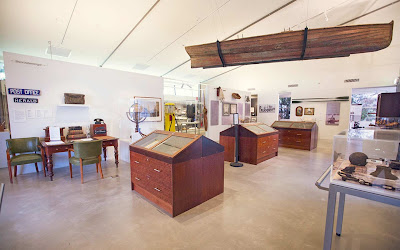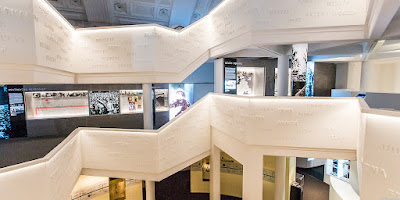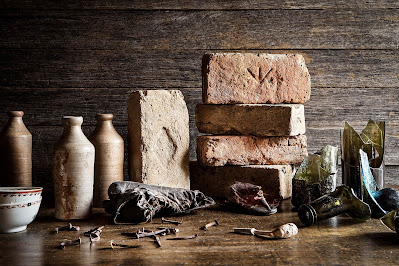A Curated Guide of Museums in Sydney, Australia
The combination of living in Sydney for most of my life and having a keen interest in archaeology, history and material culture, has meant that I have visited quite a few museums around this city. After a lengthy hiatus to finish my PhD thesis, here are some of my favourite museums around Sydney, which are shown on this map.
I would like to acknowledge the Traditional Custodians of the land these museums stand on, which was forcibly seized by colonists and continues to be Indigenous land.
Australian Museum
The Australian Museum is prominently located on the corner of William and College Street, across the road from Hyde Park and in line with St Mary's Cathedral further north. The museum building is listed on the NSW heritage register and was the first museum in Australia. The main building was originally constructed in 1849, and has had renovations and expansions over time, incorporating newer architectural styles. Its exhibitions are comprised of natural history, covering a range of animals and minerals, and cultural collections including Aboriginal and Torres Strait Islander collections, those from the Pacific, and artefacts from a range of cultures over a vast chronological period from around the world.
The 200 treasures permanent exhibition in the Long Gallery, which has recently been restored, showcases the museum's varied collection, including palaeontological specimens from many millions of years ago. Entry to the newly renovated museum is free, although there is a fee for certain temporary major exhibitions, and it is open every day.
 |
| Long Gallery at the Australian Museum |
Chau Chak Wing Museum
The University of Sydney's Chau Chak Wing Museum opened in late 2020 and combines the university's Nicholson (antiquities), Macleay (natural history and cultural artefacts), and art collections, which were previously housed separately, into one building. The collections of the university date back to the initial establishment of the university in 1850, and have been acquired throughout the last 170 years.
The four level museum has won national museum awards. Its opening exhibition in the entry level Power Gallery titled Object/Art/Specimen combines the three university collections thematically in an interdisciplinary display. The museum's website houses a range of teaching and informational resources, including a feature on early writing systems that I developed, and the Object Matters podcast. In addition to having the largest collection of antiquities in the southern hemisphere, the museum incorporates Indigenous Australian collections throughout its displays, which I explore in my article published in the University Museums and Collections Journal in 2020. The Chau Chak Wing Museum is open daily with free entry.
 |
| Object/Art/Specimen display |
Hawkesbury Regional Museum
The Hawkesbury Regional Museum is located in Windsor, at the northwestern edge of Sydney. Over the last few years, with international and domestic travel being limited, I found myself exploring areas of my own city, including the historic town of Windsor. This is a small local museum, and worth visiting if you are in the area, examining Indigenous and colonial history in the Hawkesbury region through various displays. The museum is free to visit, and open daily except Tuesday.
 |
| Hawkesbury Regional Museum |
Justice and Police Museum
The Justice and Police Museum is on Albert Street in the north of Sydney CBD, located a short walk from Circular Quay, in a former water police station. This museum is part of the extensive Sydney Living Museums network and explores stories of individuals and communities related to crime and justice from throughout Sydney's colonial history. The exhibitions do a great job of painting a vivid picture of life in colonial Sydney. I visited this museum on an open night a few months ago, at a time when music was being performed in its speakeasy and the bar was open. Patrons were grabbing a drink and sitting in the speakeasy listening to the jazzy music being played.
As well as the exhibitions, entry to the museum provides access to areas of the old police station including the booking room, and the adjacent courthouse. The museum is open on weekends and entry is currently free.
 |
| A cell in the Justice and Police Museum |
Macquarie University History Museum
Macquarie University History Museum opened to the public this week, combining artefacts of Old World (Africa, Europe and Asia) ancient history, including loans from overseas collections, along with world cultural materials, and Australian history collections exploring a range of sociocultural themes from pre-colonisation to the present day.
I had the chance to visit earlier this week and was interested by the collection of technologies from the last two centuries, in addition to the displays listed online. The museum is located on Wally's Walk in the 25C Arts Precinct at the Macquarie University North Ryde campus and takes about half an hour to look around. It is open Monday to Friday with free entry.
 |
| Inside Macquarie University History Museum |
Museum of Sydney
The Museum of Sydney is located on the spot where the house of Arthur Phillip, the first governor of Australia, was built, on the corner of Phillip and Bridge Street in the Sydney CBD. The museum focuses on Sydney's colonial history, including artefacts discovered at a range of archaeological excavations, along with photographs and digital displays.
The foundations of the original government house are marked on the ground outside the museum's main entrance. Adjacent to this is the artwork Edge of the Trees, showcasing 29 pillars of wood, steel and sandstone, symbolising the 29 Indigenous clans of Sydney, with organic material including hair, shell, bone and feathers, embedded in the pillars. The sculpture is designed to evoke the history of Sydney, stretching back to its Indigenous origins, and has names of flora carved and burnt into it in both Latin and Aboriginal languages. Walking between the pillars prompts Aboriginal voices reciting the names of places around Sydney. The museum is open Thursday to Sunday, with free entry from 5pm-8pm on Friday nights and all day during weekends.
Edge of the Trees sculpture in Museum of Sydney forecourt (By Pingpengpong)
State Library of New South Wales
The NSW State Library is the oldest library in Australia, opening in 1826, on the corner of Macquarie Street and Shakespeare Place in the Sydney CBD. The current building which houses the ornate Mitchell Library was built and developed throughout the first half of the 20th-century, and extensions including the Macquarie Street building were added in the late 1900s, with redesign continuing into the 2000s.
In addition to its extensive digital and inhouse literary resources, and spacious library rooms, including the Mitchell Library where I worked on my Honours thesis throughout 2016, the library also hosts a collection of artefacts from the colonial history of Sydney and NSW and a number of exhibition spaces. As well as permanent displays of paintings and artefacts from the library's collection, current temporary exhibitions from my recent visit are the Maps of the Pacific, showcasing intricate and detailed maps from the 14th-century onwards (exhibition ends 24th April 2022), and the Dyarubbin exhibition (exhibition ends 28th August 2022). Dyarubbin focuses on the Aboriginal history of the Hawkesbury River region developed in a collaborative project with Darug knowledge holders, comprising of a combination of historical artefacts and multimedia and serving as a timely companion to the Hawkesbury Regional Museum.
 |
| The Mitchell Reading Room at the NSW State Library |
Susannah Place
Although currently closed, Susannah Place at Gloucester Street in The Rocks is another Sydney Living Museums building. It originally housed a grocery store and workers' cottages, and was built in 1844, serving as a residential building until the 1990s. The building provides an insight into working class urban life in colonial Sydney, with furniture and decor from this period throughout the house.
I visited this museum as an undergraduate archaeology student as part of the University of Sydney Archaeology Society's annual camp at the Big Dig Archaeology Education Centre at the nearby YHA, which is built around the remains of the Cumberland Street Archaeological Site that once housed a butchery and other colonial buildings.
 |
| Kitchen at Susannah Place |
Sydney Jewish Museum
Sydney Jewish Museum opened in 1992 on Darlinghurst Road in Darlinghurst, on the edge of the Sydney CBD, and was established by Holocaust survivors. The museum features permanent exhibitions about Judaism, the Holocaust and human rights, and Jewish involvement in Australian military history. Temporary exhibitions showcase various aspects of Jewish art, culture, and wider life.
I visited the museum as a Modern History highschool student and, along with a tour of the museum, we were given a moving talk by a Holocaust survivor, which is a memory that has stayed with me. The museum is open Monday to Thursday, and Sunday, with $15 entry for adults.
 |
| Interior of Sydney Jewish Museum (LinkedIn) |
Sydney Government House
Sydney Government House is located in the Royal Botanic Gardens, serving as the official residence of the Governor of NSW. Moving from the original site of the first Government House, where the Museum of Sydney now stands, construction on this house began in 1836. My blog post from 2019 explores the history of Sydney Government House and my visit there.
 |
| Sydney Government House |
Sydney Observatory
Located at the top of Observatory Hill Park, Sydney Observatory is managed by the Museum of Applied Arts and Sciences. It is currently closed for renovation until mid-2022. With a sweeping view over Sydney Harbour, the observatory building was originally built in the late 1850s and has been maintained as an observatory and museum. With a historical role in meteorology, astronomy and scientific research in Sydney, the building is open to the public and contains an array of meteorological and astronomical tools and measuring devices, photographs and models. Night sky photography competition entries are displayed here.
In addition to being a museum, the building is also a public observatory. In 2017 I completed a course here titled Astronomical Concepts which explored aspects of the universe from the smallest atom to entire galaxies through 3D visualisations. We also had the opportunity to use the telescopes at the observatory to observe the night sky, moon and planets. The course was very informative and well worth it, and I would recommend it to anyone interested in astronomy.
 |
| Sydney Observatory at Observatory Hill Park |
The Rocks Discovery Museum
The Rocks Discovery Museum, named for its location, is nestled in Kendall Lane in a restored sandstone warehouse from the 1840s. I happened upon this museum after a delightful afternoon tea with family at the Tea Cosy a few years ago.
Over the two levels of the museum, exhibitions consisting of photographs and historical and cultural artefacts cover the history of the The Rocks through several permanent exhibitions, including the Warrane exhibit which explores Indigenous Australian occupation of this area, named after the local Aboriginal name for Sydney Cove. Other displays cover The Rocks as a colony and port, and the transformation of the area to the present day. The museum is open daily and entry is free.
 |
| Historical artefacts from The Rocks Discovery Museum |
In Summary
These are some of my favourite among a wider range of museums in Sydney, from the CBD to local government areas throughout the suburbs. I encourage you to take a bit of time to explore some of the museums within and beyond your area. In addition to the many CBD museums, most councils have local museums, and you never know what you might learn.



Comments
Post a Comment